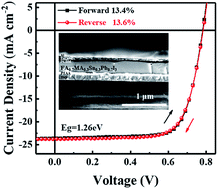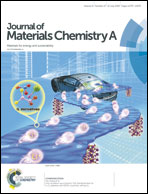Low-bandgap mixed tin–lead iodide perovskite with large grains for high performance solar cells†
Abstract
Tin (Sn) based perovskites have drawn much attention for their narrower band gap and being more eco-friendly than other solar cell materials. However, general one-step processing methods lead to poor quality Sn-based perovskite films. Here, high quality low-bandgap mixed Sn–Pb perovskite films were achieved on a hydrophobic hole transport layer via a two-step processing method from Sn0.3Pb0.7I2 and FA0.7MA0.3I precursors in sequence. The obtained dense FA0.7MA0.3Sn0.3Pb0.7I3 film shows a low-bandgap of 1.26 eV, and larger grains compared with one-step processed film. Using the high-quality film prepared, we fabricated FA0.7MA0.3Sn0.3Pb0.7I3-based inverted perovskite solar cells (PVSCs) with a maximum power conversion efficiency (PCE) of 13.6% with negligible current–voltage hysteresis, which is among the best PCEs for low-bandgap Sn-based PVSCs. The enhanced performance is attributed to reduced recombination and improved charge transportation caused by the vertically aligned larger grains and higher crystallinity in the perovskite film. The unencapsulated cells maintained 80% of their initial performance after being stored for 30 d in a glove-box. This work provides one simple path toward high quality film for high performance Sn-based perovskite solar cells.



 Please wait while we load your content...
Please wait while we load your content...